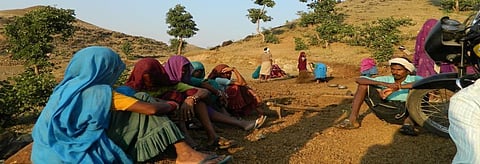Why linking MGNREGA payments to Aadhaar is a mistake
The payments of wages in MGNREGS (Mahatma Gandhi Rural Employment Guarantee Scheme) are done through the Aadhaar Payments Bridge (APB) using the Direct Benefit Transfer (DBT) systems. Section 7 of the Aadhaar Act has been applied to MGNREGA which enables the Central and state governments to establish the identity of an individual through Aadhaar for receiving subsidies, benefits or services from the government.
It is however not clear why an employment guarantee programme like MGNREGA is considered as a DBT scheme and why the NREGA workers are made to link their Aadhaar numbers with their respective job cards in order to receive payments against their work.
MGNREGA payments is neither service nor a subsidy or a benefit. It is payment against work. So, literally the MGNREGA workers are getting their remuneration against the work that they carry out, which is assigned by the Gram Panchayats and other Programme implementing agencies. The question then is why would Section 7 of the Aadhaar Act apply on MGNREGA, which is primarily a rural job scheme which provides a maximum 100 days of employment guarantee to every rural household.
The second important question is that while it has been shown through different studies and surveys that the mandatory Aadhaar impositions have only added to the plight of the rural workers, why does the government transfer the MGNREGA wages through a direct benefit transfer system.
While it is important that the MGNREGA wages are credited to the bank account provided by the workers which can be easily done through mapping of job cards and bank account numbers and channelising the wages through the system of electronic transfer, the need for Aadhaar number to be linked to the job card is not clear, which then makes the whole process confusing and troublesome.
The wages then get credited to the bank account linked to the Aadhaar number and this system creates a never-ending puzzle for the workers. It is important to mention in this context that in DBT schemes, the subsidy or the benefits get credited to the beneficiary’s bank account, which is last linked to her/his Aadhaar number.
Here is a look at the issues involved here:
1) Often the Aadhaar number of the workers are linked to other people’s bank accounts and as a result, the wages get credited to the wrong bank accounts. The scale of this issue is quite serious as we can find such issues in almost each and every Fund transfer Orders (FTO) sheets. These mistakes can be deliberate or inadvertent but the workers finally have to suffer. These misdirected transactions make life absolutely miserable for the workers who remain clueless about the cause of such issues and get stranded not knowing how to deal with such problems, as centralised payments and digital mode of implementation with a real time MIS linked execution in place, the accountability mechanisms have been completely thrashed.
2) The rural workers who have multiple bank accounts, have problems of a different kind. Whenever a worker produces her/ his Aadhaar card for E-KYC or in the time of opening a new bank account, the consent for Aadhaar linking is given by default and without the knowledge of the worker and hence their bank linking status with their Aadhaar number keeps switching between different banks and the payment of wages too keeps switching between banks. This might sound funny but in reality, there is great hardship that is added to the already hassled people. The cost involved every time people visit banks can’t also be ignored and further adds to the exploitation.
3) A large chunk of payments get rejected referring to a mysterious reason called inactive Aadhaar. It is however, how these transactions get rejected due to In-active Aadhaar and most importantly, how do the Aadhaar numbers get inactive. There are many ways the government try to explain this; However, the issues seem to have increased only in recent years. The bottom line is that such an issue occurs in case of DBT payments and creates more confusion among workers who are then made to submit their E-KYCs again. These are unnecessary troubles and makes NREGA more non-credible for the workers who are already troubled by various local issues and the system at large.
4) A lot many payments have gone to Airtel Payments Bank as the Aadhaar numbers of workers got linked to the said payments bank. Similar issues were observed in the urban areas where the LPG subsidies were going to the Airtel Payments Bank. Despite repeated assurances from the government that this problem is dealt with and that such errors will not be repeated, one can still find payments which are going to the Airtel Payments Bank.
5) Aadhaar does not help in corruption control as the means of corruption through forged muster rolls, workers working under someone else’s job card, continue to be the basic and biggest issues of MGNREGA which can only be addressed only through proper ground monitoring and a decentralised mechanism of grievance redressal. A mere Aadhaar number does not help in fixing any of those issues.
While Aadhaar-based payments have only added to the suffering of the labourers and Aadhaar’s implementation through fragile rural banking systems have only created commotion, it is high time that the government should see the ground realities which are clear as daylight.
The most important debate however is how did the government apply Section 7 of the Aadhaar Act to the payments of MGNREGA remuneration which in no way seem to be in accordance with the guideline of the Aadhaar Act. The government must clarify its intentions as over centralisation, technology-driven implementations and Aadhaar-linked payments have created a great chaos in the implementation, increased leakages and demolished accountability in the grass roots. Can we imagine our salaries being linked to the DBT, considering all the hassles that it brings with it?
This article was first published in Counterview.net


